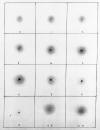
ASTRONOMICAL AND COMET DEFINITIONS
Astronomical Unit AU:
One AU, or astronomical unit, is the distance from the Sun to the
Earth, equivalent to 93 million miles or 148 million kilometers. It makes a
convenient unit of measure within the Solar System. When we say, for example,
that comet NEAT is 10 AU from the Sun, you can see right away that it is ten
times farther out than we are. Saying that NEAT is about 1,480,000,000 kms out
carries no such obvious information and requires us to absorb too many digits.
The Moon is 0.003AU from Earth or 380,000 kms.
Averted Vision:
A "trick of the trade" is to use the side of the eye when
observing rather than look directly at the astronomical object since the
side of the eye is much more sensitive to faint light. (See dark adaptation).
The most effective method for observing faint astronomical objects is when you
combine these two techniques with movement. i.e. wiggle a pair of
binoculars.
Comets
Are solar system objects traveling around the sun usually in
highly elliptical orbits. They are not atmospheric phenomena as is the
usual public misconception (see meteor). Comets are made of water ice,
silicate dust and other gases. They are typically 1-10kms in diameter and
developed beyond Neptune in the cold depths of the solar system. As a comet
approaches the sun, ice sublimates to form a large coma surrounding
the nucleus. The solar wind sweeps away the ionized gases to form an ion
tail which always points away from the sun. Dust particles released from the
nucleus form the dust tail which sweeps behind the comet along its orbit.
Comets are designated by year of discovery followed by half month of discovery
('I' is not included) followed by numerical order of discovery followed by name
of discoverer. e.g. 2001 Q4 was the 4th comet discovered during the second half
of August 2001.
Dark Adaptation:
An essential requirement for observing astronomical objects.
Dark Adaptation requires the observer to avoid direct light for at least 5
minutes prior to observing (preferably 20 minutes). The eye in total darkness will progressively develop
a light sensitive pigment called Rhodopsin (a derivative of Vitamin A) which
enables greater peripheral vision at night. Persons lacking in Vitamin A will suffer from
"night blindness". To maintain dark adaptation during the night,
avoid white light. A torch wrapped in red
cellophane is an essential observing tool.
Degree of Condensation:
DC is an indicator of how much the surface brightness of the coma
increases toward the center of the coma. In general, DC=0 indicates totally
diffuse and DC=9 means "stellar." As the DC increases, the coma size usually
decreases and becomes more sharply defined. A totally diffuse comet, with no
brightening toward the center, is rated DC=0. With DC=3-5, there is a distinct
brightening. By DC=7 you have a steep overall gradient and by DC=8 the coma is
very small, dense and intense with fairly well defined boundaries. With DC=9 the
comet looks like a soft star or a planet in bad seeing. In general the DC will
increase as a comet approaches the Sun and decrease as it recedes from the Sun.
Ephemeris Items:
Consists of the objects
Right Ascension (RA) and Declination at a particular date,
r = distance to Sun in AU,
Delta = distance to Earth in AU,
mag = objects predicted magnitude,
Elong = objects elongation from the Sun in degrees.
If less than 30 degrees, object is considered too difficult to observe.
Phase = Sun-object-Earth angle in degrees.
Greatest length of a comet's tail usually occurs around a phase angle of
90 degrees.
Magnitude:
The brightness of stars and other celestial objects is described
in terms of magnitude. The magnitude scale was created by the Greek astronomer
Hipparchos sometime near 180 BC. He labeled the brightest stars he could see as
magnitude 1, the next brightest as magnitude 2, down to the dimmest at magnitude
6. The definitions were arbitrary. When people started using telescopes, the scale was extended to dimmer stars,
meaning magnitudes greater than 6. Also, decimals were added to allow one to
distinguish stars of roughly the same brightness; for example, Polaris, the
North Star, is of magnitude 2.02. Very bright objects can even have zero or
negative magnitudes;
for example, Sirius, the brightest star in the sky, is of magnitude -1.58; the
planet Jupiter is about -2; Venus -4; the full moon -11; the Sun -26.
This table indicates the faintest stars a dark adapted observer may achieve in a moonless
night sky:
| inner city unaided eye | magnitude 3 to 4 |
| outer suburb unaided eye | magnitude 4 to 5 |
| country unaided eye | magnitude 6 |
| 7x50mm binoculars | magnitude 7 to 8 |
| 60mm telescope | magnitude 9 to 10 |
| 200mm telescope | magnitude 11 to 13 |
Meteor
Or "Shooting Star" is a small particle, usually cometary debris,
striking the Earth's atmosphere causing it to glow temporarily.
Perihelion:
An object orbiting the sun is said to be at Perihelion when it is
closest to the sun.